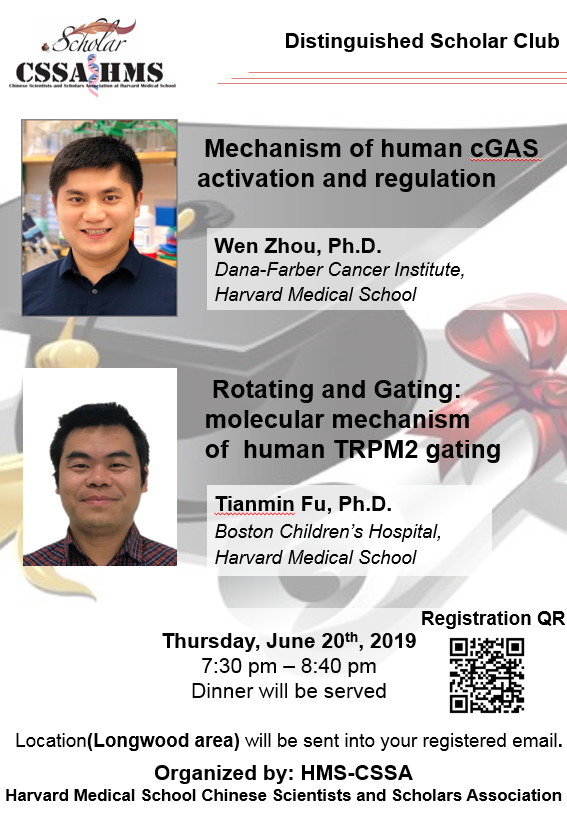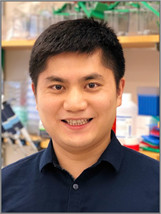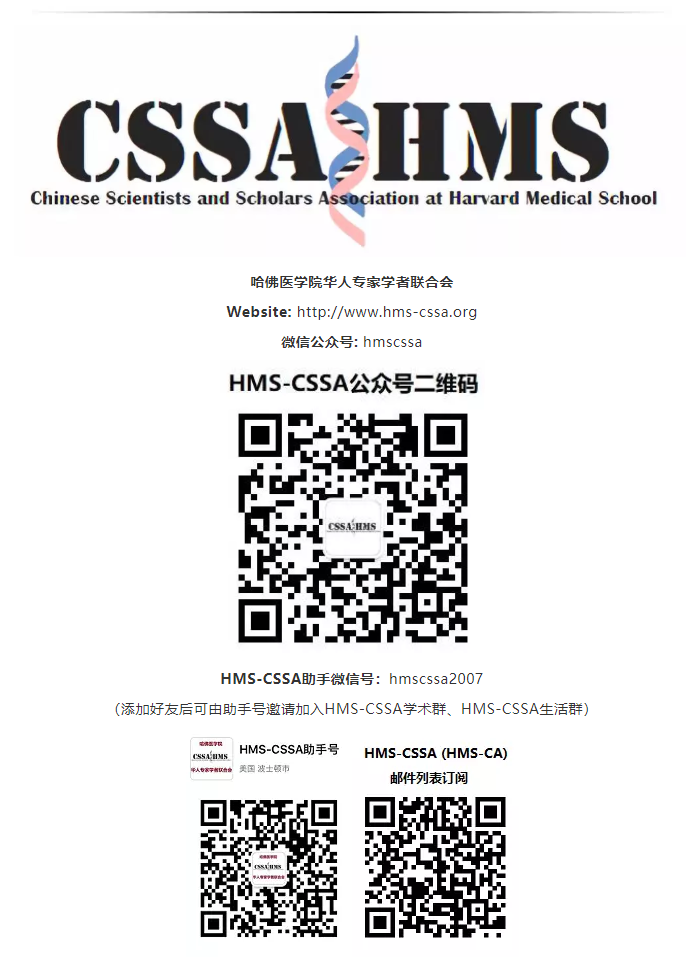2019

Distinguished Scholar Club: Wen Zhou & Tianmin Fu
Distinguished Scholar Club
Mechanism of human cGAS activation and regulation
Wen Zhou, Ph.D.
Dana-Farber Cancer Institute, Harvard Medical School
Rotating and Gating: molecular mechanism of human TRPM2 gating
Tianmin Fu, Ph.D.
Boston Children’s Hospital, Harvard Medical School
Time: June 20th 7:30pm-8:40pm
Location: (Longwood area) will be sent into your registered email.
Registration: https://www.eventbrite.com/o/hms-cssa-19869719186
Dinner will be served.

Dana-Farber Cancer Institute, Harvard Medical School
Dr. Wen Zhou is driven to understand the fundamental mechanism of protein–nucleic acid interactions and how these complexes determine the cellular and organismal function using biochemistry, structural biology and cell biology. After joining HMS/DFCI as a postdoc, his research focus on an innate immunity enzyme, called Cyclic GMP–AMP synthase (cGAS), that allows cells to recognize pathogen- and tumor-derived cytosolic DNA. In collaboration with collogues, he showed that cGAS DNA-sensing is adapted for human-specific regulation not present in other mammalian homologs. Dr. Zhou is now trying to fully understand how human cGAS is activated and regulated.
Highlighted publications (2018-2019):
1. Zhou W*, Whiteley AT*, de Oliveira Mann CC, Morehouse BR, Nowak RP, Fischer ES, Gray NS, Mekalanos JJ, Kranzusch PJ. Structure of the human cGAS–DNA complex reveals enhanced control of immune surveillance. Cell, 2018,174, 300–311. (* co-first authors)
·Preview featured in Immunity: “Human cGAS Has a Slightly Different Taste for DNA”
·Press releases: Harvard Medical School “Guardian of the Cell”
·Press releases: Parker Institute for Cancer Immunotherapy “Key Cancer Detection Protein”
2.Barnett KC, Coronas-Serna JM, Zhou W, Ernandes MJ, Cao A, Kranzusch PJ, Kagan JC (2019). Phosphoinositide Interactions Position cGAS at the Plasma Membrane to Ensure Efficient Distinction between Self- and Viral DNA. Cell, 2019, 176, 1432–1446.
3.Zhang L, Zhou W, Che L, Rochaix JD, Lu C, Li W, Peng L. PPR protein BFA2 is essential for the accumulation of the atpH/F transcript in chloroplasts. Frontiers in Plant Science, 2019, doi: 10.3389/fpls.2019.00446
4.Zhou W, Whiteley AT, Kranzusch PJ (2019). Analysis of human cGAS activity and structure. Methods in Enzymology (In proof).

Cellular and Molecular Medicine, Boston Children’s Hospital, Harvard Medical School
In the past few years, Dr. Tianmin Fu had brought several projects to fruition on death receptor signaling, innate immune signaling, and channel gating. First, he uncovered the assembly and activation mechanisms of death receptors Fas and DR5 in collaboration with Dr. James Chou. By resolving the structures of the transmembrane domains of these receptors, they revealed a unique trimeric assembly mechanism of Fas and a higher-order oligomeric assembly mechanism of DR5 that are of vital importance for signal transduction. They went further to elucidate how Fas and DR5 activate the downstreameffector caspase-8 by determining the cryo-EM structure of the caspase-8 tandem death effector domain filament. Second, Dr. Fu published the structures of ASC CARD, NLRC4 CARD, and NLRP6 PYD filaments, which provide mechanistic insights into inflammasome assembly and activation in innate immunity. These studies established a new paradigm for signal transduction, namely the activation of protein complexes through oligomeric and higher-order assemblies. Recently, he determined the cryo-EM structures of the full-length human TRPM2 channel in apo, primed, and open states. Together, these structures provide a full picture of TRPM2 gating and also suggest a general principle of TRP channel gating, which may apply to many other TRP families.
Highlighted publications (2018-2019):
1.Wang L.*, Fu, T.M.*#, Zhou, Y., Xia, S., Greka, A., Wu, H.#Structure and gating mechanism of human TRPM2. Science, 2018, 362: eaav4809 PMID:30467180 (*co-first author, #co-corresponding author).
2.Pan, L.*, Fu, T.M.*, Zhao, W.*, Zhao, L.*, Chen, W., Qiu, C., Liu, W., Liu, Z., Piai, A., Fu, Q., Chen, S., Wu, H., Chou, J.J. Higher-order clustering of the transmembrane achor of DR5 drives signaling. Cell, 2019, 176: 1477-89 PMID:30827683 (*co-first author)
3.Fu, T.M., Shen, C., Li, Q., Zhang, P., Wu, H. Mechanism of ubiquitin transfer promoted by TRAF6. Proc. Natl. Acad. Sci. USA, 2018, 115: 1783-88. PMID:29432170, PMCID: PMC5828637.
4.Shen, C., Lu, A., Xie, W.J., Ruan, J., Negro, R., Egelman, E.H., Fu, T.M.#, Wu, H.# Molecular mechanism for NLRP6 inflammasome assembly and activation. Proc. Natl. Acad. Sci. USA, 2019, 116: 2052-57. PMID:30674671. (#Co-corresponding author)
5.Li, Y.*, Fu, T.M.*#, Lu, A., Witt, K., Ruan, J., Shen, C., Wu, H#. Cryo-EM structures of ASC and NLRC4 CARD filaments reveal a unified mechanism of nucleation and activation of caspase-1. Proc. Natl. Acad. Sci. 2018, USA, 115: 10845-52. PMID:30279182. (#Co-corresponding)
(撰稿:岳宏)
(校正: 曹婵 张彦波 黄林昌)
(排版:李江)
参见微信公众号文章